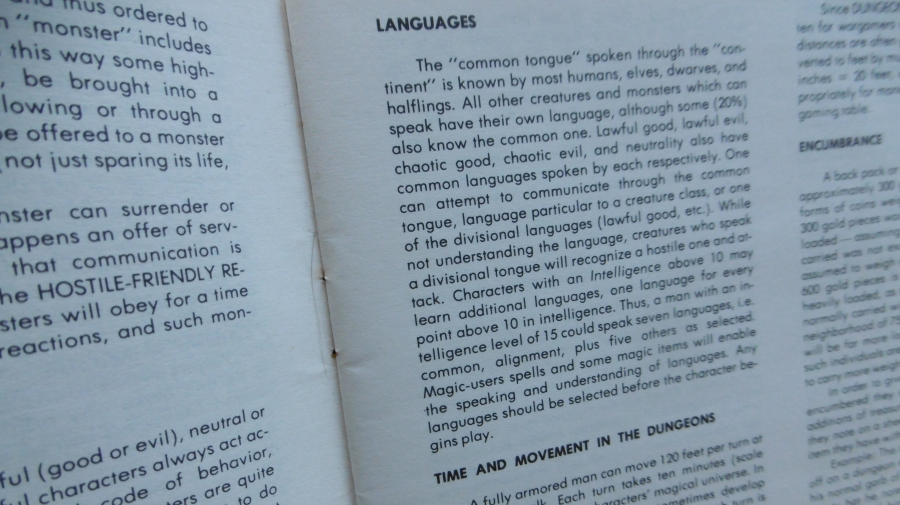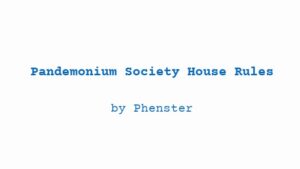In the September 1984 “Dispatch from the Campaign Desk,” Dave introduces Phenster’s contribution:
“Phenster tells us a story wrapped around ways the Pandemonium Society uses languages, and he throws us a few more crumbs about Hazard’s Heptarchy campaign setting” (L’avant garde #67).
MYSTERIORUM LIBRI
Hexalogy
We found a book in the dungeon. None of us could read it. It was written in "a strange script with an evil air about it." That's how Hazard described it. We found it in a green dragon's hoard with a lot of treasure from the Old Empire, vases, jewelry and scrolls and stuff.
Phenster Prime knows O.E., which is what we call the ancient common language of the Old Empire (he also knows Orcish, Elvish, Mythic and the Wyrm Utterances, q.v.), so we decided to go to the Lundgre Towers, a big city ruled by magic-users. There's a huge library there, where we could do some research and find out what the language was and decipher some of the script. I say "we" but it was mostly me and Cypher doing the research. Friar Tombs went off on a quest for the church with the rest of the party except Jinx and Beowulf. Highway Jinx made contact with the city Thieves' Guild, but he hasn't told us what mission he did yet, and Beowulf the Bully got into a brawl at the Pen Alembic on the first night and spent a whole month hanging by a chain from Tower Gaol.
It took us a while to find anything in the library. It's so big it has its own dungeon! It was an adventure, but eventually, we found the "MYSTERIORUM LIBRI QUINQUE" (The Five Books of Mystery). It's really just one big book, all written in O.E. Hazard uses Latin words for O.E. to make it sound different from English, which is the Common language of course. He uses other real languages (usually old ones) for other old languages in the Heptarchy.
The Five Books of Mystery tell all about how a special kind of magic works. The first book is a primer on a language called the Forty-Eight Keys. That's the language the book we found is written in. The Keys (for short) are used to communicate with creatures from other planes of existence. We translated the title of the book we found. It's called The Sixth and Sacred Book of Mystery. We still have to translate the whole book, but it's supposed to tell us how we can get to a place called the MYSTICAL HEPTARCHY. We think it's a parallel plane of existence, but we don't know why we'd want to go there.
We can learn extra languages during the campaign in addition to the ones we know at 1st level from our intelligence. That's how I learned the local Mythic. We have to find a teacher and work out the teaching fee (depends on the teacher but at least 100 g.p. per month), and it takes 6 plus 1d6 months to learn a normal language or 6+3d6 for complex languages, like the Utterances or Doppleganger. Subtract one month per extra language you already know (not counting Common or Alignment). You can usually study a language during off-time and still go on adventures. I wanted to learn the Forty-Eight Keys, but the only teacher I found in Lundgre was this weird, old guy that smelled like sulphur. His name was Enoch the Tower Hermit. He said I'd have to stay in his tower the whole time without ever going out. I didn't want to keep Phenster Prime out of the campaign for so long. I'd rather be adventuring. And that guy was just too weird.
Here's how Hazard worked out languages in the GREAT HALLS campaign. I use a similar system in games I run, and some other DMs in the Pandemonium Society use it too. Complex languages (q.v.) have an asterisk (*).
Monster Languages
Dwarvish/Gnomish/Kobold: Gnomish and Kobold are dialects of Dwarvish. If you know Dwarvish, you can learn Gnomish or Kobold in half the normal time.
*Elvish/Fairy is the common language in Elfland. Most fairy creatures speak it.
Goblinish: All the goblin types speak Goblinish: goblins, hobgoblins, bugbears, and wargs.
Orcish: There are so many different dialects of Orcish that whenever you talk in Orcish, there's always a chance to misunderstand or be misunderstood. If that happens, there's usually a fight. It's better to speak Common with orcs if they speak Common or not talk at all and evade if possible.
*Gnoll is difficult to learn and speak because the sounds aren't like what people usually can make.
Ogrish: Ogres speak a dialect of Common. We can usually communicate with an ogre, if it wants to talk.
*Wyrm Utterances or Wyrmspeak is a primordial language. The dragons call it "Mother's Tongue" because Tiamat taught it to the first dragons. She learned it by licking the stones on the Shores of Time, which split her tongue. That's why dragons and lizards have split tongues.
*Entish uses words and chemical signals passed between treekfolk by their roots. It takes years (instead of months) to learn Entish, and even then you talk in a dialect because you don't have roots or the right chemicals.
*Doppleganger is an alien language. It sounds different than all the other languages because it doesn't really have words like we think about them.
Other Languages Spoken by Humans
Old Common: Not many books are written in Old Common, but a lot of graffiti in the Great Halls is written in it. It's an earlier form of Common that's still used by folks in remote areas of the Heptarchy. Some monsters out there speak it, too, instead of Common. (Old English)
O.E.: Lots of books are written in the language of the Old Empire. A lot of books from earlier times were translated to O.E. too, so sages usually know it. It's also the linga franca of the Church. Cleric scrolls are written in O.E. or Common. All clerics have to know O.E. by 3rd level or they have trouble advancing in the Church hierarchy. (Latin)
Caerlon: Several native tribes inhabit wilderness areas in the Heptarchy. They are called the "First Peoples," and they speak Caerlon, which has a musical sing-song cadence. Caerlon has many dialects, but they're all similar, so different tribes mostly understand each other. They also write on scrolls and pottery and carve on stones and cave walls. (Celtic)
The Mythics*: There were lots of other empires and civilizations way before the Old Empire. The Mythic languages were common tongues back then. Some of them are still spoken by people in the Faraway Lands (which is everywhere outside the Heptarchy) and mythical creatures, like medusas, minotaurs, centaurs, cyclopes and giants and such. That was before they had books, and any scrolls written in the Mythics turned to dust long ago, but some copies have been made, and there might be clay tablets. Or so Hazard says, we haven't found any yet. (Norse [for our local Mythic], Greek [far to the south], Egyptian)
Runic is a lost magical language. It used symbols (or runes) to convey meaning and store magic power. We find the runes sometimes on small, flat stones and dungeon walls. Some powerful wizards and a few sages know the names of the runes. We can pay a sage to tell us a rune's name, but they won't teach Runic to anybody. (Futhark)
Alignment Languages
Alignment languages are a whole other thing. They aren't like normal languages, but they aren't magic either. Hazard says they are "integral" to the world, like if you change alignments you just don't know the old alignment language anymore and you do know the new one, just like that.
The Basic rulebook has 5 alignments. AD&D has 9 and every one has its own alignment language. I agree with Hazard when he says that's way too many. In the GREAT HALLS campaign, we have the 5 alignments, but there are only 2 alignment languages: the Words of Law and the Dark Speech of Chaos. They are spoken languages with gestures, usually not written. But sometimes we find words or short phrases engraved in stone or jewelry. They are often magicked in some way.
Lawful characters can speak Law Words. It's impossible to tell a lie with Words of Law. Chaotics know the Dark Speech. There are a million ways to tell lies and half truths in Dark Speech. Chaotic good characters usually don't use the Dark Speech, even though they can understand it. Lawful evil characters use Words of Law for their malevolent designs. Neutrals don't know either one of these languages.
More Mysteriorum
Tombs & co. were successful in their quest. They retrieved a religious relic, the Stormgod's Chalice, from an evil temple. That gives Tombs some clout with the Lundgre Matriarch. He wants to get his own bishopric.
While we were staying at the Pen Alembic, some shady characters started hanging around. They always sat at the table next to us, wearing hooded cloaks, and they seemed to be listening to what we said. Beowulf wanted to fight them, but we talked him out of it. We didn't want to wait around while he spent another month hanging from Tower Gaol. Jinx's contacts in the Thieves' Guild informed him that someone was asking around about us, where we were from and what we were doing in the city. When we finally left the Lundgre Towers, somebody was following us. We asked Jinx if all that could have something to do with his mission. He didn't give us a straight answer.
This is the 27th in a continuing series of articles, which reedits house rules for Holmes Basic D&D from 40-year-old game club newsletters. Mentions of house rules are in bold text and followed by a [bracketed category designator].
For rules category descriptions and more about the newsletters, see “About the Reedition of Phenster’s.” For an index of articles, see Coming Up in “Pandemonium Society House Rules.”
Phenster’s Pandemonium Society House Rules is a work of fiction. Names, characters, businesses, events, incidents, and newsletters are either products of the author’s imagination or are used in a fictitious manner. Any resemblance to actual persons, living or dead, or actual events is pure coincidence.

The 1977 edition of Gygax and Arneson’s DUNGEONS & DRAGONS is also known as “Holmes Basic” after editor Dr. J. Eric Holmes.


Pingback: Pandemonium Society House Rules – DONJON LANDS
Pingback: Models for Languages in Make-Believe Worlds – DONJON LANDS